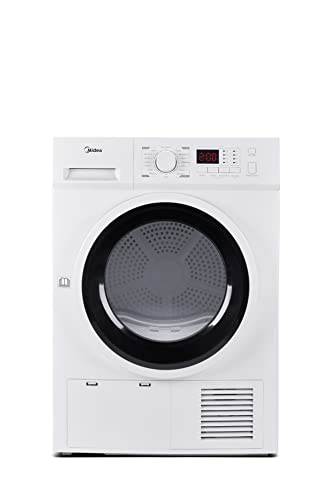Why You'll Definitely Want To Read More About Heatpump Dryer

How to Properly Use a Heatpump Dryer
In contrast to conventional dryers, which make use of hot air to dry clothes, a heat pump dryer uses electricity to transfer water from the fabric and into its compressor. The moisture is then dehumidified and heated in the process creating a low-temperature drying process.
ENERGY STAR offers several heat pump dryers that have a 4-cubic-foot capacity that are smaller than the traditional American standard-sized models (which typically have a capacity of 7 cubic feet). The smaller sizes may qualify for rebates and are also smaller.
Energy Efficiency
Energy efficiency is an important feature of a heatpump dryer. It utilizes the energy of ambient air to dry clothes, and doesn't the waste heat or exhaust like conventional dryers do. Heatpump dryers are able to save homeowners up $600 on energy costs during the lifetime of the device. The use of renewable resources can also make them less environmentally harmful than traditional dryers.
The energy efficiency of heatpump dryers is determined by the COP (coefficient-of-performance) which is the ratio between cooling capacity and the power consumption. The more COP is higher is, the more efficient the heat pump is. The dryers that use heat pump energy consume less than regular dryers.
In addition to cutting down on energy consumption, the low temperature of the heat pump dryer reduces drying time by enhancing the dehumidification capacity of the system. Jia et al. (1993) evaluated a combination heat pump and microwave dryer that included a loop thermosyphon for low temperature grain drying. They discovered that the system used less than 2.1 MJ per kg water removed.
Heat pumps can be used in conjunction with other drying methods to increase energy efficiency. For instance atmospheric freeze drying could be combined with a heat source to produce a process that is less expensive than vacuum freeze drying, and provides products similar to those created by vacuum freeze drying (Bantle and others. 2009).
Many rebate programs provide incentives to purchase heatpump dryers, even though the initial investment could be higher. For example the IRA's Energy Star program provides rebates to households who have reduced their whole-home energy usage by 35 percent or more. This makes the initial cost of heatpump dryers more affordable for families with a small budget.
A heatpump dryer can be an excellent option for those who are seeking the most efficient method of drying. It is estimated that a heatpump dryer can reduce energy consumption by up to 40% when compared with traditional dryers and is one of the most efficient methods to dry clothes at home.
Convenience
These dryers, which are relatively new in the United States are gaining popularity because of their energy efficiency and climate benefits. They're also more gentle on clothing since they dry at lower temperatures and use moisture sensors to stop overheating. These features reduce shrinkage and damage to clothing, making them more cost-effective than traditional electric dryers.
The main feature that distinguishes a heat pump dryer from conventional models is the closed loop system they employ to recycle air and store moisture during drying. Instead of heating and dumping hot air and water into the environment through exhaust vents, they employ refrigerant and compressor to continuously recycle the same air and collect excess moisture.
This process is similar to the process used in refrigerators in that the compressor heats the air, and then transfers it to an evaporator that is cold. The water vapor condenses in a pan. The dry air is recirculated in the drum, and the excess moisture is sent into the drain pan. The condensation drain hose connects to the sewer line in your home which eliminates the necessity for an exhaust vent in most instances.
The heat pump dryers cut down on energy costs and are quieter. Some models even have sound-dampening technologies for added convenience. They're also less trouble to maintain than conventional dryers. Because they don't need vents to work, they have fewer parts and less chance of breaking. They don't need gas lines like vented dryers. This can be expensive to repair or replace.
The only drawback to the convenience is that heat pump dryers tend to take longer to dry than traditional models. They operate at lower temperature settings and could require several times to get the laundry completely dry. However, this is often compensated by reducing electricity usage and incorporating energy-efficient modes to compensate for this delay.
The Miele T1 heat pump dryer, for example is able to save up to 60% in energy consumption and has a lower noise level thanks to its vibration reduction system. It also features smart functionality like EcoDry or PerfectDry that assesses the calcium content in your water to ensure that your drying is safe and consistent. The dryer is Wi-Fi-compatible and can be controlled remotely by using a smartphone app.
Easy Installation
A heat pump dryer utilizes an exclusive compressor to transfer heat from the air to the laundry. It can be put in any place, as it doesn't require vents. It's a good choice for tiny homes, accessory dwelling units (e.g. an apartment over the garage) and even additions. You can even stack a heat pump dryer and washers to make space.
This kind dryer has the primary drawback that it takes longer than a vented dryer to dry loads. It's less energy-intensive and it doesn't produce any unpleasant odors. It also reduces the amount of laundry you need to wash and can help keep your clothes looking fresher for longer.

Heat pump dryers are available in small sizes which are easy to install even in tight space. If you're looking to purchase a more large model, consider an ENERGY STAR certified heat pump dryer with larger drums. There are also heat pump dryers with an infrared heater, which helps speed up drying by heating the fabric and clothes directly.
The first step to installing a heat-pump dryer is to prepare your intended installation area. This includes clearing out any clutter and blocking off the area around the dryer to ensure adequate airflow. Then, you must prepare the power outlet by ensuring that it is exclusively for this appliance. Check whether the amps and voltage are the same as what is stated in your user manual. Connect the dryer to an electrical outlet and run a brief test cycle. Clean the lint filters after every use. Check and clean the exhaust pipe frequently to prevent getting clogged.
To get the most out of your heat pump dryer, make sure you follow the manufacturer's guidelines for the size of the load and temperature settings. This will allow your dryer's energy consumption to be minimized and it will run more efficiently. my latest blog post is also essential to schedule annual maintenance with a qualified technician to ensure that everything is working efficiently. They can also inspect your ductwork for obstructions or damage which could be reducing the efficiency.
Maintenance
When properly utilized when used properly, heat pump dryers can be an investment that is worth the home. However, they require regular inspections cleaning, maintenance, and cleaning to ensure that they are operating properly and efficiently throughout the year. These tips can help you extend the life of your dryer, decrease energy usage and save money.
The condenser drain and lint filters should be kept free of obstructions. To prevent clogging and decreased performance, the lint filter should be cleaned after every use. Make sure to check the vent hose frequently for any kinks or blockages. A blocked vent can cause longer drying times and is a major fire risk. It is recommended to remove and clean the vent hose frequently by using a dryer lint remover or an attachment for a vacuum cleaner to ensure that it's thoroughly cleaned, eliminating any trace of lint or debris.
Cleaning the heat exchanger regularly is also vital. This component transfers heat to clothes from the air and is prone to becoming blocked over time by lint, which results in a decrease in efficiency and shorter cycles. The dryer's manual for the user to get specific instructions on how to access and clean the heat exchanger. Once you've cleaned your heat exchanger, wash and dry it thoroughly before placing it back into the dryer.
Place the dryer in an area that is well-ventilated, away from obstructions like walls and other obstacles. This will ensure that the dryer is well ventilated and avoids overheating.
It is also important to clean the drum and exterior of your dryer frequently. This will help prevent staining and keeps the interior of the dryer free of dirt, dust, and grime. You can use a damp cloth or mild detergent to clean the surface of your dryer and avoid using abrasive cleaners that may damage the surface.
In addition to these maintenance tips It is also recommended that you seek professional maintenance and service for your heat pump dryer at least once a year. A professional will be able to assess and clean your dryer's internal components, making sure that all components are in good working order.
